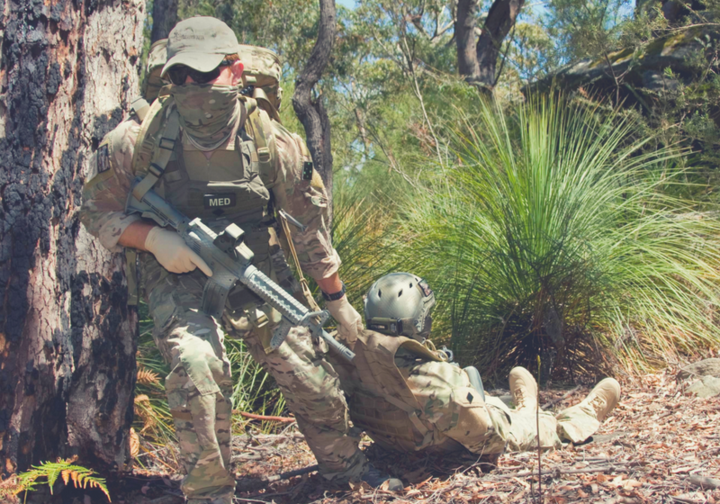The Afghan village was deathly quiet and still in the early hours of the morning as our element of Special Operations soldiers approached it silently on foot. It had been a 4-hour walk in from our helicopter insertion point and I was approaching 24 hours without sleep. I could feel the tiredness behind my eyes and my 40kg pack weighed heavily on my shoulders, my combat uniform was soaked through with sweat. Our element briefly stopped in a creek line to survey the village before infiltration, and a final set of orders was given at a whisper before we broke into smaller teams and headed towards our designated target compounds. My tiredness began to lift slightly and my senses began to focus, the distant barking of a dog drew my attention and my head snapped quickly to its approximate location, my eyes intently scouring the area for signs of movement in the eerie green image created by my Night Vision Goggles. Nothing, we proceeded silently to our target. Within 100 metres of our target compound, my attention was suddenly drawn to a blinding flash of light to my immediate left, which temporarily caused my Night Vision Goggles to whiteout and fail. A fraction of a second later a deafening explosion ripped through the silence of the morning, causing every member of my team to stop dead in their tracks and focus on the fireball erupting from the blast. The IED risk for the target had been assessed as extreme and it was likely that one of our teams had hit one. I felt a surge of warm adrenaline initiate in the middle of my back and proceed to cloak my shoulders and head, causing my scalp to tingle and goosebumps to form on my arms. My heart began to thump hard in my chest and I felt invigorated, my pack, which had weighed heavily on my shoulders during insertion seemed weightless, my vision and hearing sharpened, and every fibre of my body stood ready for what came next. Seconds later the village erupted with gunfire, galvanizing my team into action. We sprinted to the nearest mud-brick compound, our lead operator effortlessly kicking the door of the compound off its hinges without breaking stride. Upon entry, we fell spontaneously into our room clearance drills, and once the compound was secured we positioned ourselves to join the fight. The chemicals surging through my veins from the experience made me once again feel high, my drug of choice – combat.
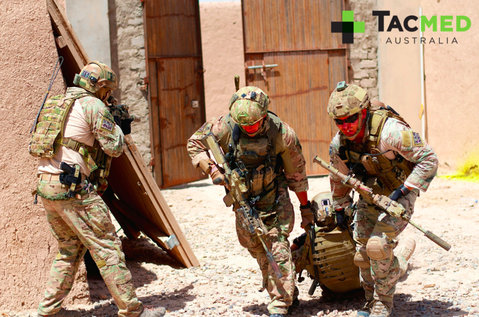
The startle or stress response that I had experienced was the result of a complex series of events within the body, which prime us to respond in a threat situation. It is not unique to humans, and its origins are thought to date back tens of millions of years to the most basic forms of life on earth. The evolution of the stress response occurred out of necessity for basic life forms to be able to identify a threat in the form of predators, and ideally be able to avoid becoming prey. The fundamentals of the response system are hardwired into the most primitive parts of the human brain and can be triggered in fractions of a second by certain stimuli.
The stress response is initially triggered by a threat stimulus of some description, usually a loud noise, pain, or a visual stimulus that is considered threatening. This stimulus is registered by the sensory cortex and sensory thalamus of the brain which then, in a fraction of a second, transmit the signal to the hub of the stress response, the amygdala
(Lang, P, Bradley, MM, Cuthbert, BN 1998; Milad 2006). Once stimulated the amygdala rapidly disperses signals out to several other centres of the brain to simultaneously activate the physiological responses that we associate with fear.
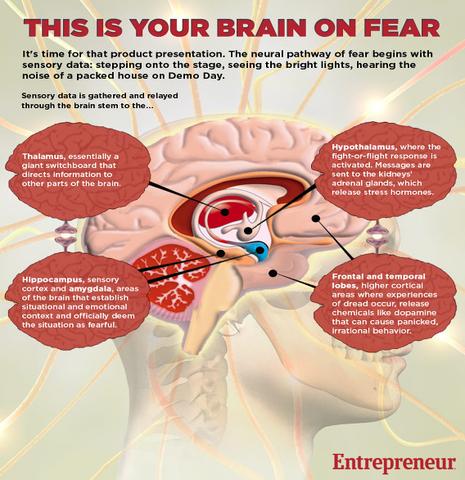
Picture credit: www.enduringmind.co.uk
The initial response to a threat stimulus is known as a startle reflex, which causes us to immediately freeze in place, as well as involuntarily blink and become hyper-alert (Davis 1998; Lang, P, Davis, M, Ohman, A 2000). When looking at the evolutionary significance of this startle response, movement is a key factor that allows a predator to identify prey, so by freezing still at the first sign of threat the potential prey minimises its chances of being detected. The rapid blinking of the eyes is thought to be a protective reflex to shield the eyes from any immediate danger that may be associated with the threat stimulus.
Whilst still frozen in the startle reflex phase of the stress response, the amygdala furiously fires signals to another area of the brain known as the hypothalamus, which is responsible for regulating the hormones of the body’s sympathetic nervous system. These hormones stimulate what is commonly known as the fight or flight response, and they include noradrenaline, dopamine and serotonin, amongst others (Stockhorst 2016). The physiological effects of these hormones occur within seconds of a stress stimulus and act to prime the body for action. The pupils of the eyes dilate to let in more light and sharpen visual acuity, breathing and heart rate increase to pump more oxygenated blood around the system, blood vessels in the gut constrict and blood is shunted to the muscles in anticipation of use, sweat glands are stimulated to aid in cooling the body, and a protein called renin is released from the kidneys, which tightens the body’s blood vessels and boosts blood pressure. The body is then in an optimal state to stay and fight the threat if required, or turn and flee from it at maximum speed. This initial stress response happens within seconds of a threat stimulus and is followed within minutes by the release of a second wave of chemicals (Milad 2006). These include the hormone glucagon, which liberates stored sugar reserves from within the body, increasing blood sugar levels in order to provide a source of fuel to fight or flee. Also released in the second phase of the stress response are the body’s natural opiates, which cause the euphoric feeling associated with extreme sports and keep the so-called adrenaline junkies going back for one more base jump.
Interestingly it has been shown that a large percentage of humans, being diurnal (awake during the day) have a heightened state of anxiety and increased stress response to stimulus in the dark (Davis 1998). This explains why many of us fear the dark, and why events that otherwise wouldn’t startle us during the day do so at night. It also explains why horror movies seem far scarier in the dark than they do during the day. Horror movie producers also use the stress response to their advantage by playing sudden loud noises in synchrony with scary scenes, which triggers an acoustic startle reflex and a subsequent stress response in viewers (Davis 1998).
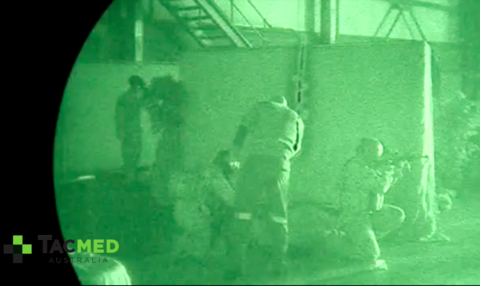
With the evolution of the higher order cognitive functions of the human brain has come the ability to influence the stress response for both better and worse. In its overactive state the imagination can induce a stress response simply by thinking of stressful stimuli, and in extreme cases this can induce paralyzing anxiety in patients (Lang, P, Bradley, MM, Cuthbert, BN 1998). Likewise, if memories are formed under stress, such as a combat soldier hearing the noise of a helicopter during a traumatic event, the subsequent sound of a helicopter may trigger the memory and induce what is known as a Post Traumatic Stress Reaction (Lang, P, Davis, M, Ohman, A 2000). In extreme cases this can develop to be come a disabling disorder.
The same higher order cognitive functions of the brain can be used to train the brain to better cope with stressful stimuli, and reduce the stress response to stimulus. This process of desensitisation is used to treat those with anxiety disorders and specific phobias by gradually exposing them to the trigger of their anxiety in a controlled fashion. For instance, a patient with a severe spider phobia might be exposed initially to discussion about spiders and pictures of them, and then gradually work up to exposures to real spiders when their suppression of their phobia had reached an appropriate stage. In a similar fashion, combat soldiers exposed to repetitive, realistic training scenarios can undergo a process of fear extinction (Stockhorst 2016) in which the evolutionary fear response is modulated to the point where the soldier is able to function optimally in a stressful situation which might debilitate an untrained person and render them paralysed with fear. This, combined with the natural opiates released as part of the stress response, contributes to why a percentage of soldiers who experience combat can’t wait to get in a firefight again.
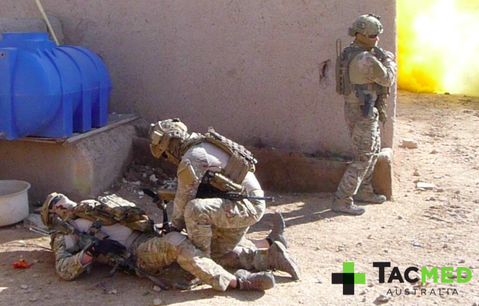
In the extreme opposite end of the anxiety, spectrum exists people who have little to no stress response to a stimulus. In this setting, the person doesn’t receive the negative feedback associated with fear and the stress response and may exhibit antisocial, or psychopathic behaviours due to the lack of negative feedback.
In summary, the stress response mechanisms in modern man have evolved over millennia as a protective mechanism, and have been further complicated by the development of the higher-order cognitive functions of our brains. For the majority of us, our stress response serves us well, alerting us to threat and priming us for optimal performance in situations such as sporting events or public speaking commitments. Should the stress response system become slightly unregulated or be triggered inappropriately however, such as in clinical anxiety or PTSD, the effects can be debilitating for the sufferer. In this setting through no fault of the individual, their body automatically prepares itself for flight or fight at inappropriate times. The good news is that help is available for these conditions, and if you feel that you are experiencing anxiety or PTSD, please don’t continue to face it alone. Make an appointment with your GP or psychologist and start the process of standing down your body’s fight or flight system.
References:
- Davis, M 1998, ‘Are Different Parts of the Extended Amygdala Involved in Fear versus Anxiety?’, Biological Psychiatry, vol. 44, no. 12, pp. 1239-1247.
- Lang, P, Bradley, MM, Cuthbert, BN 1998, ‘Emotion, Motivation, and Anxiety: Brain Mechanisms and Psychophysiology’, Biological Psychology, vol. 44, no. 12, pp. 1248-1263.
- Lang, P, Davis, M, Ohman, A 2000, ‘Fear and anxiety: animal models and human cognitive psychophysiology’, Journal of Affective Disorders, vol. 61, no. 3, pp. 137-159.
- Milad, M, Rauch, SL, Pitman, RK, Quirk, GJ 2006, ‘Fear extinction in rats: Implications for human brain imaging and anxiety disorders’, Biological Psychology, vol. 73, no. 3, pp. 61-71.
- Stockhorst, U, Antov, MI 2016, ‘Modulation of Fear Extinction by Stress, Stress Hormones and Estradiol: A Review’, Frontiers in Behavioral Neuroscience, vol. 9, no. 359, pp. 1-26.
